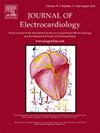Estimating very low ejection fraction from the 12 Lead ECG among patients with acute heart failure
IF 1.3
4区 医学
Q3 CARDIAC & CARDIOVASCULAR SYSTEMS
引用次数: 0
Abstract
Background
Identifying patients with low left ventricular ejection fraction (LVEF) in the emergency department using an electrocardiogram (ECG) may optimize acute heart failure (AHF) management. We aimed to assess the efficacy of 527 automated 12‑lead ECG features for estimating LVEF among patients with AHF.
Method
Medical records of patients >18 years old and AHF-related ICD codes, demographics, LVEF %, comorbidities, and medication were analyzed. Least Absolute Shrinkage and Selection Operator (LASSO) identified important ECG features and evaluated performance.
Results
Among 851 patients, the mean age was 74 years (IQR:11), male 56 % (n = 478), and the median body mass index was 29 kg/m2 (IQR:1.8). A total of 914 echocardiograms and ECGs were matched; the time between ECG-Echocardiogram was 9 h (IQR of 9 h); ≤30 % LVEF (16.45 %, n = 140). Lasso demonstrated 42 ECG features important for estimating LVEF ≤30 %. The predictive model of LVEF ≤30 % showed an area under the curve (AUC) of 0.86, a 95 % confidence interval (CI) of 0.83 to 0.89, a specificity of 54 % (50 % to 57 %), and a sensitivity of 91 (95 % CI: 88 % to 96 %), accuracy 60 % (95 % CI:60 % to 63 %) and, negative predictive value of 95 %.
Conclusions
An explainable machine learning model with physiologically feasible predictors may help screen patients with low LVEF in AHF.
从12导联心电图估计急性心力衰竭患者极低的射血分数。
背景:在急诊科使用心电图(ECG)识别低左室射血分数(LVEF)患者可以优化急性心力衰竭(AHF)的管理。我们的目的是评估527个自动12导联心电图特征用于估计AHF患者LVEF的有效性。方法:分析患者的医疗记录(bb0 ~ 18岁)和ahf相关的ICD代码、人口统计学、LVEF %、合并症和用药情况。最小绝对收缩和选择算子(LASSO)识别重要的心电特征并评估性能。结果:851例患者中,平均年龄为74岁(IQR:11),男性56% (n = 478),中位体重指数为29 kg/m2 (IQR:1.8)。共匹配914张超声心动图和心电图;超声心动图间隔时间为9h (IQR = 9h);≤30% LVEF (16.45%, n = 140)。Lasso证明了42个心电图特征对估计LVEF≤30%很重要。LVEF≤30%的预测模型曲线下面积(AUC)为0.86,95%可信区间(CI)为0.83 ~ 0.89,特异性为54%(50% ~ 57%),敏感性为91 (95% CI: 88% ~ 96%),准确度为60% (95% CI: 60% ~ 63%),阴性预测值为95%。结论:一个具有生理上可行预测因子的可解释的机器学习模型可能有助于筛选AHF低LVEF患者。
本文章由计算机程序翻译,如有差异,请以英文原文为准。
求助全文
约1分钟内获得全文
求助全文
来源期刊

Journal of electrocardiology
医学-心血管系统
CiteScore
2.70
自引率
7.70%
发文量
152
审稿时长
38 days
期刊介绍:
The Journal of Electrocardiology is devoted exclusively to clinical and experimental studies of the electrical activities of the heart. It seeks to contribute significantly to the accuracy of diagnosis and prognosis and the effective treatment, prevention, or delay of heart disease. Editorial contents include electrocardiography, vectorcardiography, arrhythmias, membrane action potential, cardiac pacing, monitoring defibrillation, instrumentation, drug effects, and computer applications.
 求助内容:
求助内容: 应助结果提醒方式:
应助结果提醒方式:


